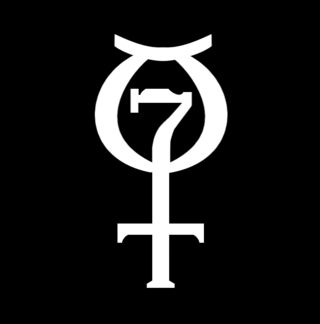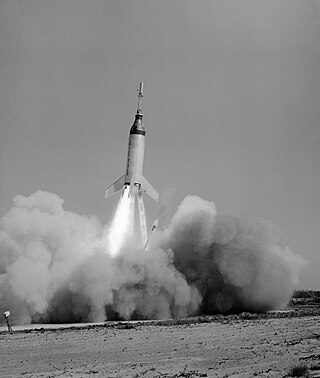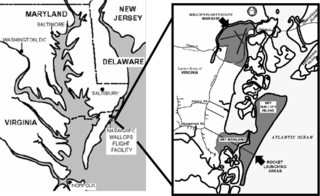
Project Mercury was the first human spaceflight program of the United States, running from 1958 through 1963. An early highlight of the Space Race, its goal was to put a man into Earth orbit and return him safely, ideally before the Soviet Union. Taken over from the US Air Force by the newly created civilian space agency NASA, it conducted 20 uncrewed developmental flights, and six successful flights by astronauts. The program, which took its name from Roman mythology, cost $2.68 billion. The astronauts were collectively known as the "Mercury Seven", and each spacecraft was given a name ending with a "7" by its pilot.

Splashdown is the method of landing a spacecraft in a body of water, usually by parachute. The method has been used primarily by American crewed capsules including NASA’s Mercury, Gemini, Apollo and Orion along with the private SpaceX Dragon. It is also possible for the Russian Soyuz and the Chinese Shenzhou crewed capsules to land in water, though this is only a contingency.

Mercury-Atlas 5 was an American spaceflight of the Mercury program. It was launched on November 29, 1961, with Enos, a chimpanzee, aboard. The craft orbited the Earth twice and splashed down about 200 miles (320 km) south of Bermuda, and Enos became the first primate from the United States and the third great ape to orbit the Earth.

Before humans went into space in the 1960s, several other animals were launched into space, including numerous other primates, so that scientists could investigate the biological effects of spaceflight. The United States launched flights containing primate passengers primarily between 1948 and 1961 with one flight in 1969 and one in 1985. France launched two monkey-carrying flights in 1967. The Soviet Union and Russia launched monkeys between 1983 and 1996. Most primates were anesthetized before lift-off.

Animals in space originally served to test the survivability of spaceflight, before human spaceflights were attempted. Later, many species were flown to investigate various biological processes and the effects microgravity and space flight might have on them. Bioastronautics is an area of bioengineering research that spans the study and support of life in space. To date, seven national space programs have flown non-human animals into space: the United States, Soviet Union, France, Argentina, China, Japan and Iran.

The Little Joe 2 was a test of the Mercury space capsule, carrying the rhesus monkey Sam close to the edge of space. He was sent to test the space equipment and the adverse effects of space on humans.

Mercury-Redstone 1A (MR-1A) was launched on December 19, 1960 from LC-5 at Cape Canaveral, Florida. The mission objectives of this uncrewed suborbital flight were to qualify the spacecraft for space flight and qualify the system for an upcoming primate suborbital flight. The spacecraft tested its instrumentation, posigrade rockets, retrorockets and recovery system. The mission was completely successful. The Mercury capsule reached an altitude of 130 miles (210 km) and a range of 235 miles (378 km). The launch vehicle reached a slightly higher velocity than expected - 4,909 miles per hour (7,900 km/h). The Mercury spacecraft was recovered from the Atlantic Ocean by recovery helicopters about 15 minutes after landing. Serial numbers: Mercury Spacecraft #2 was reflown on MR-1A, together with the escape tower from Capsule #8 and the antenna fairing from Capsule #10. Redstone MRLV-3 was used. The flight time was 15 minutes and 45 seconds.

Mercury-Redstone 2 (MR-2) was the test flight of the Mercury-Redstone Launch Vehicle just prior to the first crewed American space mission in Project Mercury. Carrying a chimpanzee named Ham on a suborbital flight, Mercury spacecraft Number 5 was launched at 16:55 UTC on January 31, 1961, from LC-5 at Cape Canaveral, Florida. The capsule and Ham, the first great ape in space, landed safely in the Atlantic Ocean 16 minutes and 39 seconds after launch.

Little Joe 1 (LJ-1) was a failed launch of a Little Joe by NASA, a solid fuel rocket that was designed for a Max Q abort and launch escape system test for the Mercury capsule. The objective was to determine how well the escape rocket would function under the most severe dynamic loading conditions anticipated during a Mercury-Atlas launching.

Little Joe 1A (LJ-1A) was an uncrewed rocket launched as part of NASA's Mercury program on November 4, 1959. This flight, a repeat of the Little Joe 1 (LJ-1) launch, was to test a launch abort under high aerodynamic load conditions. After lift-off, the pressure sensing system was to indicate when the correct abort dynamic pressure was reached. This should have happened about thirty seconds after launch. A signal was sent to the explosive bolts to separate the spacecraft from the launch vehicle. Up to this point, everything was going as planned. The impulse was also intended to ignite the escape motor. The motor was ignited, but it took a number of seconds to build up thrust, and thus the abort maneuver was not accomplished at the desired dynamic pressure. Because of this, a repeat of the test was planned. Other events from launch through recovery occurred without incident. An altitude of 9 statute miles (14.5 km) and a range of 11.5 statute miles (18.5 km) were obtained, and a speed of 2,021.6 miles per hour (3,254 km/h) was reached. Flight time 8 minutes 11 seconds. Payload 1,007 kg.

The Little Joe 6 was a launch escape system test of the Mercury spacecraft, conducted as part of the U.S. Mercury program. The mission used a boilerplate Mercury spacecraft. The mission was launched October 4, 1959, from Wallops Island, Virginia. The Little Joe 6 flew to an apogee of 60 kilometres (37 mi) and a range of 127 kilometres (79 mi). The mission lasted 5 minutes 10 seconds. Maximum speed was 1,375 metres per second (3,075 mph) and acceleration was 5.9 g (58 m/s²). Payload 1,134 kilograms (2,500 lb).

Little Joe 5 was the November 8, 1960, unmanned atmospheric test flight of the Mercury spacecraft, conducted as part of the U.S. Mercury program. The objective was to test a production Mercury capsule (#3) and the launch escape system during an ascent abort at maximum dynamic pressure. The mission was launched from Wallops Island, Virginia. Sixteen seconds after liftoff, the escape rocket and the tower jettison rocket both fired prematurely. Furthermore, the booster, capsule, and escape tower failed to separate as intended. The entire stack was destroyed on impact with the Atlantic Ocean. The Little Joe 5 flew to an apogee of 10.1 miles (16.2 km) and a range of 13 miles (20.9 km). Some capsule and booster debris was recovered from the ocean floor for post flight analysis.

Little Joe 5B was an uncrewed launch escape system test of the Mercury spacecraft, conducted as part of the US Mercury program. The mission used production Mercury spacecraft # 14A. The mission was launched April 28, 1961, from Wallops Island, Virginia. The Little Joe 5B flew to an apogee of 2.8 miles (4.5 km) and a range of 9 miles (14 km). The mission lasted 5 minutes 25 seconds. Maximum speed was 1,780 mph (2865 km/h) and acceleration was 10 g (98 m/s²). The mission was a success and Mercury spacecraft # 14A was recovered.

Little Joe 5A was an uncrewed launch escape system test of the Mercury spacecraft, conducted as part of the U.S. Mercury program. It was an attempted re-test of the failed Little Joe 5 flight. The mission used production Mercury spacecraft #14 atop a Little Joe booster rocket. The mission was launched March 18, 1961, from Wallops Island, Virginia. The LJ-5 failure sequence was repeated when capsule escape rocket again ignited prematurely with the capsule remaining attached to the booster. In this flight however, a ground command was sent to separate the capsule from the booster and escape tower. This allowed the main and reserve parachutes to deploy and the capsule was recovered with only minor damage. It would be used again on the subsequent Little Joe 5B mission, in a third attempt to achieve mission objectives. The Little Joe 5A flew to an apogee of 7.7 miles (12 km) and a range of 18 miles (29 km). The mission lasted 5 minutes 25 seconds. Maximum speed was 1,783 miles per hour (2,869 km/h) and acceleration was 8 G (78 m/s²).

Little Joe II was an American rocket used from 1963 to 1966 for five uncrewed tests of the Apollo spacecraft launch escape system (LES), and to verify the performance of the command module parachute recovery system in abort mode. It was named after a similar rocket designed for the same function in Project Mercury. Launched from White Sands Missile Range in New Mexico, it was the smallest of four launch rockets used in the Apollo program.

Wallops Flight Facility (WFF) is a rocket launch site on Wallops Island on the Eastern Shore of Virginia, United States, just east of the Delmarva Peninsula and approximately 100 miles (160 km) north-northeast of Norfolk. The facility is operated by the Goddard Space Flight Center in Greenbelt, Maryland, and primarily serves to support science and exploration missions for NASA and other federal agencies. WFF includes an extensively instrumented range to support launches of more than a dozen types of sounding rockets; small expendable suborbital and orbital rockets; high-altitude balloon flights carrying scientific instruments for atmospheric and astronomical research; and, using its Research Airport, flight tests of aeronautical research aircraft, including unmanned aerial vehicles.

Little Joe was a solid-fueled booster rocket used by NASA for eight launches from 1959 to 1961 from Wallops Island, Virginia to test the launch escape system and heat shield for Project Mercury capsules, as well as the name given to the test program using the booster. The first rocket designed solely for crewed spacecraft qualifications, Little Joe was also one of the pioneer operational launch vehicles using the rocket cluster principle.

A boilerplate spacecraft, also known as a mass simulator, is a nonfunctional craft or payload that is used to test various configurations and basic size, load, and handling characteristics of rocket launch vehicles. It is far less expensive to build multiple, full-scale, non-functional boilerplate spacecraft than it is to develop the full system. In this way, boilerplate spacecraft allow components and aspects of cutting-edge aerospace projects to be tested while detailed contracts for the final project are being negotiated. These tests may be used to develop procedures for mating a spacecraft to its launch vehicle, emergency access and egress, maintenance support activities, and various transportation processes.

The Wallops Flight Facility Visitor Center is located in Building J-17, Wallops Island, Virginia, United States along Route 175. It contains exhibits highlighting past missions conducted at NASA's Wallops Flight Facility. The visitor center also provides information about current activities at Wallops Flight Facility, such as the sounding rocket, balloon and aircraft program. The outside grounds has a rocket garden consisting of rockets and aircraft used for space and aeronautical research, including a full-scale four-stage reentry vehicle used to study the Earth's atmosphere. In addition, the visitor center has educational programs on Earth and space science. It is also a viewing area for rocket launches.






















